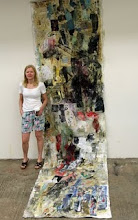skip to main |
skip to sidebar
 acrylic, pencilIllustration Friday topicThe Inspiration - a century old photograph showing two soldiers, dressed in the uniform of the Russian Imperial Army.
acrylic, pencilIllustration Friday topicThe Inspiration - a century old photograph showing two soldiers, dressed in the uniform of the Russian Imperial Army.
Description: Some faces and names had vanished without trace as if they never existed, while other will live long in the memories after they have gone.
The concept - The "nonpersons" cut from a series of photomontage images done by Gustav Klutsis: Politburo of the USSR, 1935, Vintage gelatin silver print
When faced with the task of creating a collective portrait, Klutsis chose to apply a photomontage technique to mediate the power relationships between the Politburo members, to show the strict internal hierarchy governed by quasi-military discipline. The schematic representation fiddles with the scale of the characters, awkwardly crops facial features, and puts all emphasis on Stalin's face, accented by the darker values of background.
'The relation between what we see and what we know is never settled. Although every image embodies a way of seeing, our perception or appreciation of an image depends upon our way of seeing. The past is never there waiting to be discovered, to be recognized for what it is.' - John Berger.
 final: ink, gouach, acrylic
final: ink, gouach, acrylic linocut print
linocut print thumbnail
thumbnail
 sketchesGary Kelley' assignment was to illustrate the color blue. The method, introduced during the academy presentation, was to make a list and have corresponding icons.My list: blue bird, underwater, blue river larger than a mile, pearl, blue bear, blue moon, blueberry, blueberry nights, the lunar hare, two metaphysical beings – blue, the sea horse, blue sky – the Heavenly cock, the nymphs, the rain bird, simurgh, siren, the fairies, the elves, haokah, the thunder god, the valkyries, the basilisk, the griffon, Swedenborg’s devils, the jinn, the unicorn, fauna of mirrors, the lemurs, ichthyocentaurs, mermaids.The decision was to draw a happy bird from the play The Blue Bird by Maurice Maeterlinck. The story revolves around a girl called Mytyl and her brother Tyltyl, who went on a journey to find the blue bird of happiness. The picture captures the moment at which the bird is flying above a schematically resolved city and the two children are looking at her.
sketchesGary Kelley' assignment was to illustrate the color blue. The method, introduced during the academy presentation, was to make a list and have corresponding icons.My list: blue bird, underwater, blue river larger than a mile, pearl, blue bear, blue moon, blueberry, blueberry nights, the lunar hare, two metaphysical beings – blue, the sea horse, blue sky – the Heavenly cock, the nymphs, the rain bird, simurgh, siren, the fairies, the elves, haokah, the thunder god, the valkyries, the basilisk, the griffon, Swedenborg’s devils, the jinn, the unicorn, fauna of mirrors, the lemurs, ichthyocentaurs, mermaids.The decision was to draw a happy bird from the play The Blue Bird by Maurice Maeterlinck. The story revolves around a girl called Mytyl and her brother Tyltyl, who went on a journey to find the blue bird of happiness. The picture captures the moment at which the bird is flying above a schematically resolved city and the two children are looking at her.
Pictorial elements from gzhel' and lubok, such as the lack of a sense of depth and the stylized surface decoration, were utilized in the designing of the page layout.
The first variant was inspired by children’s books illustrations by Ivan Bilibin, who along with other members of "Mir Isskustva" defined the Russian style of the Silver Age.
The line was the basis in his illustrations, while stylization and ornamentation were employed in creating his famously intricate designs. The second design, with a more simplified delineator structure, maintaining only the most descriptive features, depends on the expressive quality of linocut. The inspiration here was Little Mice children's book, illustrated by Vera Yermolayeva.
 thumbnails
thumbnails

Hamlet, oil on canvasAssignment presented by Jon FosterThe assignment was to draw a book character, and to convey definite thoughts and emotions by gestures and facial expression.
The man in the portrait is wearing a dark jerkin, blood-red cloak, dark beret pulled down on his eyes, mouth somehow twisted, light-haired.
The illustration depicts early morning at the upper terrace of Ellsinore.
That night, the Ghost appears to Hamlet and reveals to him that he is the spirit of his father, murdered by Claudius. Hamlet gives his promise to take revenge upon his uncle. Hamlet' emotional life, all his loves and hatreds, was reversed overnight.
Red fabric indicates the violent emotions experienced by the character, while his dark clothes are the outer sign of his inner grief and hesitation.
Soft light is shining from the upper left corner. The contours of the castle are not clear; however, there is a relative clarity of elements in the space around him with an emphasis on his figure. He is not looking at the viewer; there is no sense of interaction with the character, who appears to be consumed by his emotions. His face is painted in a warm palette, forming a contrast with gloomy, grayish and desaturated staircase.
Complex emotions of distress, isolation, anger, revenge, hate, and anxiety are reflected at his face.Special thanks to John English who helped with rendering facial features.







































